Fiction into Film is a series devoted to page-to-screen adaptations. The process of translating prose to the visual medium is a tricky and only intermittently successful one, but even the fumbles provide a great platform for understanding stories, and why they affect us the way they do.
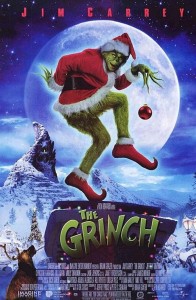 Imagine being a parent in 1966. An adaptation of Dr. Seuss’ How the Grinch Stole Christmas!, directed by living legend Chuck Jones, is about to debut. This story, which your kids are likely already familiar with, is a Christmas classic, and this seems like a great opportunity to relive the experience with your family. Together you watch as a new holiday tradition is born, the resonant simplicity of the original tale feeding perfectly into the deep charm and visual wit of one of animation’s greatest minds.
Imagine being a parent in 1966. An adaptation of Dr. Seuss’ How the Grinch Stole Christmas!, directed by living legend Chuck Jones, is about to debut. This story, which your kids are likely already familiar with, is a Christmas classic, and this seems like a great opportunity to relive the experience with your family. Together you watch as a new holiday tradition is born, the resonant simplicity of the original tale feeding perfectly into the deep charm and visual wit of one of animation’s greatest minds.
Imagine being a parent in 2000. An adaptation of Dr. Seuss’ How the Grinch Stole Christmas!, directed by living legend Ron Howard, is about to debut. This story, which your kids are likely already familiar with, is a Christmas classic, and this seems like a great opportunity to relive the experience with your family. Together you watch as an old holiday tradition dies before your eyes, your family powerless to save it. The resonant simplicity of the original tale is smothered tragically by nonsensical padding and soulless physical comedy from a director you’re starting to realize isn’t very good.
That’s the thing about Ron Howard. He’s such a nice guy, so effortlessly winning, so personable and sweet, such a champion of young talent, that it’s easy to lose sight of the fact that he’s not really much of a director.
I mean no disrespect by this. I have nothing against him as a person, and I’ve never heard a negative word spoken about the man. From the moment he first stole America’s hearts as Opie on The Andy Griffith Show, Howard has been revered as a minor national treasure. Which is wonderful…even if that goodwill does render his films disappointingly immune to wide-scale criticism.
We like Ron Howard. Hell, it’s hard not to. But liking the man does not mean we need to like (or even respect) his films, which range from passable to profoundly embarrassing. To my knowledge, Howard has never directed a great — or even particularly good — film.
At his best, Ron Howard achieves gentle mediocrity. And while there’s nothing wrong with gentle mediocrity, it’s not much of a justification for his continuing directorial cachet.
Of course, “mediocre” is not “bad,” and I don’t mean to suggest that it is. There are many (many) mediocre films, songs, and novels that I enjoy greatly, if not deeply. My point isn’t that Howard is lousy; more that his films don’t seem like products of a coherent artistic vision. At their best, they tick the boxes that need to be ticked. His best work, that is to say, achieves what we expect every film to achieve at the bare minimum. He scrapes by, deserving neither damnation nor praise. He knows how to make a film work, but not how to make a film artistically succeed.
The archetypal Ron Howard film, in my estimation, is Apollo 13. Whether you like the film or not, it’s difficult to argue that it does much wrong. It’s equally difficult to argue that it does much right, with few shots, sequences, or edits bearing the mark of anyone who has something to say. I saw the film multiple times as a child, but today I’d be hard pressed to tell you much about it. It was there, I have a vague memory of not hating it, and life went on. If I were to watch it again tonight I’d likely forget just as much about it tomorrow.
Howard directs white bread. It’s filling enough, but anyone who thinks about what they’re about to consume would likely choose just about anything else.
The closest Howard has ever come to shocking America into reconsidering its love for him was with 2000’s The Grinch, the very existence of which seems almost like a dare. “You like me so much,” he seemed to say, “that I could urinate all over something you treasure, and you’d still think I’m great.”
He was wrong. The film made its money — coasting on Howard’s reputation far more than reinforcing it — but the critical response was not kind. And while the Dr. Seuss book and the Chuck Jones special are still holiday staples of households everywhere, it’s rare that Howard’s The Grinch makes an appearance outside of discount bins and Blockbuster closeouts.
Part of the problem with adapting How the Grinch Stole Christmas! is overcoming the fact that there already exists a very popular, very good, and very important adaptation that yours will inevitably be measured against. (See also: Tim Burton’s Charlie and the Chocolate Factory.) In fact, one might argue that the existence of an already great and timeless adaptation completely negates the need for another attempt, which, in a best-case scenario, would ruin only 3/5 of America’s childhoods.
For reasons known only to him and anyone who’s ever used money, though, Ron Howard gave it a whirl, and in doing so he managed the impossible: he made the magic of Dr. Seuss feel dreary, dull, and dour. It turns out that marrying a lively and inventive source text to a director whose approach has never exceeded workmanlike would dampen the material rather than elevate it. Who could have guessed?
Before we get too far into things, a quick note on the title. The film was originally called The Grinch, but at some point prior to its home video release it became Dr. Seuss’ How the Grinch Stole Christmas. (There’s also a regional element at play here, as — so far as I can tell — the film was still called The Grinch for UK home release.) This change is unfortunate for several reasons, not least because it now shares its title with the Chuck Jones animated masterpiece — inviting unfavorable comparison, to say the least — and because the addition of Seuss’ name implies a degree of fidelity to his original…a move as deliberately and frustratingly misleading as it was when Bram Stoker’s Dracula pulled the same trick.
I’m going to refer to this film as The Grinch, which should make this both easier to write and easier to read. After all, if we’re dealing with the original book, the Jones adaptation, and the Howard adaptation, and we refer to all of them by the same title, there’s bound to be some confusion.
Of course, that confusion couldn’t possibly exist on any level beyond the title, as Howard’s film is inept in just about every conceivable way.
I’m not exaggerating. It’s wall-to-wall maddening, and to even begin discussing its crimes would require a piece so long and frustrated that nobody in their right mind would attempt to write such a thing during the busiest time of year.
So, here you go!
Part of Howard’s problem in adapting How the Grinch Stole Christmas! comes, of course, from the limited scope of the source material. It’s only 50 pages long, and those are 50 pages by children’s storybook standards; each page is dominated by illustration (Seuss’ own), and text is deliberately sparse. In order to fill a feature film, Howard would have to invent a great deal of material wholecloth.
As such, we can’t exactly begrudge him for limited fidelity. (And, as readers of this series know, “limited fidelity” is often a boon to adaptations.) But we can begrudge him for the quality of this new material, which is uniformly quite low. To take Seuss’ lean, potent original and bog it down with flabby, uninventive nonsense is bad enough. But to bog it down for two interminable hours is downright criminal. That easily overshoots narrative necessity and lands squarely in the realm of excess.
The impact of Seuss’ original cannot be overstated. The Grinch is, quite simply, an important part of modern Christmas mythology. The fact that he’s existed for a mere 60 years or so is incredible, as he’s only slightly less recognizable in the public consciousness than Ebenezer Scrooge, and in some households is as recognizable as Santa Claus.
He’s an important part of our understanding of the holiday, and the Scrooge comparison is an apt one: the Grinch was not a revelatory character; he exists alongside a famous Christmas grump that we already had. Scrooge gave a name and a face to a character type everybody knew well, and cemented him in a work of enduring fiction that we could all read, appreciate, and revisit through the years, learning his lesson along with him every time.
The endurance of Scrooge is not surprising. The Grinch, however, serves an almost identical purpose, and the level of his utility doesn’t compare to Scrooge’s. He didn’t give a name or a face to anything; he gave something another name and face. The fact that the Grinch endures is not a testament to our need of a character to represent yuletide sourness; it’s a testament, simply, to the fact that we love the Grinch.
Seuss’ tale could actually be seen as an adaptation of Dickens’ A Christmas Carol. The Grinch, like Scrooge, begins the story as a curmudgeon who hates Christmas and deliberately tries to rob it of the joy it brings others…and he ends it, like Scrooge, an enthusiastic celebrant. His transformation is more abrupt, however, as the Grinch seems to skirt visits from the ghosts of Christmas Past and Yet to Come, receiving all the perspective he needs from a single vision of Christmas Present.
It’s a lean — and only barely modernized — retelling of an already lean holiday classic, but it amounts to more than an echo of its predecessor; it’s an old story told in a new, wholly charming, inimitable way. That is to say, it’s told in Seuss’ voice.
The rhymes and rhythm carry us through the story in a bounding way that’s about as far removed from Dickens’ wordy, winding prose as possible. Both stories are playful, but Seuss crafts a playful universe. Scrooge may crack cruelly wise or employ a brainy turn of phrase, but the Grinch exists in a whole reality built on quirk. The world he occupies is not our own, even though the lesson he learns unquestionably is.
Dickens wanted us to understand that Scrooge’s journey applied — potentially — to every one of us. The Grinch, on the contrary, is a product of clear and unapologetic fabrication. He’s the sugar coating on a bitter pill. Both stories give us the same holiday nourishment, but children get the sweeter vitamin.
When Chuck Jones adapted the story, he didn’t so much deviate from the source material as he did weave his spirit of visual invention into it. The brief parable fit easily into a half-hour time slot, and we ended up with a retelling that was at least as sharp and memorable as the original. In fact, it’s become an enduring holiday classic in its own right, with many of us being more familiar with the animated version than we are with the original static pages.
The existence of Jones’ masterful, beloved adaptation means that every ounce of fat on Howard’s version feels that much more unnecessary, and unwelcome. How the Grinch Stole Christmas! doesn’t need to be two hours long. Heck, we know empirically that it doesn’t even need to be one hour long. When Jones accomplished so much in 20 minutes, an audience is right to be disappointed when Howard accomplishes exponentially less in 120 minutes.
Comparing Howard’s adaptation to Jones’ might seem unfair, but it’s a comparison that Howard himself unwisely invites. Stealing its title (How Ron Howard Stole the Title!) was just the last in a string of overt nods; for instance, The Grinch helps itself to both songs written for the Jones special (“You’re a Mean One, Mr. Grinch” and “Welcome Christmas,” the latter of which Jim Carrey exaggeratedly mocks for its nonsense lyrics…a poor decision for a film dedicated to coasting on its own nonsense), and lifts the sight gag of the Grinch’s heart growing a literal three sizes. (In Seuss’ original text the growth remains figurative.)
On top of all that, though, The Grinch is indebted to the Jones special in a way that it might not even realize: it’s Jones who made the Grinch green.
In Seuss’ book — which he illustrated himself — the only color employed is a sparing red. It’s used in a few different shades, but aside from that singular chromatic flourish, everything is rendered in black and white. It was Jones’ special that turned the Grinch green, and gave him those sickly yellow eyes. (They were, as you might guess, originally red.)
These are physical details that we take for granted, but they weren’t there until Jones put them there. The fact that so few people remember the fact that the Grinch was white (and the fact that many of you are learning this here for the first time) speaks to just how much of an impact Jones’ special had, and how much it achieved.
Seuss wrote the story and Jones defined its presentation. Two works of enduring invention, functioning together. Howard had big shoes to fill if he wanted to follow that double punch, but he didn’t just fail to live up to his predecessors; he failed to find anything interesting to do with the property at all.
In order to pad out the story, we get some needless (and artless) exploration of the Grinch’s childhood. (See, again, Charlie and the Chocolate Factory, which also believes that if you need to kill time and don’t feel like being creative, you can slap a sad childhood in there and move along.)
The most superficial concern with the film is also, sadly, one of the steepest barriers to enjoying it: the fact that everybody is absolutely hideous.
This is a relevant comment to make while we talk about the Grinch’s weepy backstory, what with the nightmare-inducing abomination that is the Grinch-baby at its center — a creature that I happen to know was rejected from a David Cronenberg film for being “needlessly disgusting” — but it’s a problem that blankets the film in general, and it’s one that The Grinch never manages to overcome.
This is absolutely one of those times that fidelity to the source material should be a minor concern at best; a much more important concern would be, are each of these characters an affront to God? But, strangely, physical appearance is the one aspect of the adaptation in which Howard seems to believe fidelity is key, as though the reason everyone enjoyed How the Grinch Stole Christmas! is that they had fun imagining themselves thronged by a crowd of swollen, distended freaks.
Seuss, of course, famously populated his stories with characters that didn’t necessarily look human, but what works in illustration can’t always be expected to translate to live action. For instance, we have no problem watching The Simpsons or South Park without being repulsed by the odd physical appearances of the characters, but that’s because their appearances aren’t odd for their universes; they’re part of a larger artistic style. Translate those characters to live-action though — that is to say, use makeup and prosthetics to shape an actual human being into those exact proportions, with those colors and those oddly arranged features — and you’d end up with something horrifying.
Why? Because once you stick them in a live action setting, we start comparing them to our universe. And if you see in our universe a human male with Homer’s yellow skin, gigantic eyeballs, and impossibly round frame, your first impulse would be to put him out of his misery.
Seuss’ characters were works of visual invention. Jones’ retelling used a style similar to Suess, but was also unmistakably the work of Jones, slotting comfortably alongside his Looney Tunes output. It’s the work of one great artist filtered through the sensibilities of another, and we ended up with something greater than the sum of its already impressive parts.
In order to successfully translate a static image to another form of presentation — be it animation, live-action film, or anything else — some effort needs to be made to actually translate it, as opposed to copy it.
Howard doesn’t understand this, and so he populates his film with characters who simply don’t work in the live-action medium. He remains true to the letter of Seuss’ design, without understanding the spirit. Seuss’ artwork was charming and unique because he was aware of his medium, and what worked within it. Had Seuss instead worked in television or film, he likely would have taken a different approach to best suit those media. His concern wasn’t that his characters look like this…it was that what he was creating was unique, effective, and memorable. Those are three things that change from medium to medium, and Seuss understood that.
Howard doesn’t, and so he films Lovecraftian nightmare creatures because they look — superficially — like what Seuss drew. (And maybe it’s just me, but I think if you’re filming a Dr. Seuss adaptation full of Lovecraftian nightmare creatures, you need to step back and reconsider your artistic choices.)
In fairness, Howard may not be entirely to blame for this. Three years after The Grinch we got an equally hideous adaptation of The Cat in the Hat, and both that film and this one were produced by Howard’s longtime collaborator Brian Grazer, seemingly not content with having just one misguided and hated Dr. Seuss adaptation on his resume.
The worst part of how creepy and unsettling the characters look is the fact that, at some early stage of production, Howard and his team recognized this…and they chose not to change their approach.
How do I know they were aware that their characters were visually unpalatable? Easy: they reacted to it in their design of Cindy-Lou Who, played here by a very young Taylor Momsen.
In the original work and the Jones adaptation, Cindy-Lou Who is the briefly glimpsed ray of innocence that (arguably) provides the initial spark for the Grinch’s eventual change of heart.
She serves a similar purpose in this film, which posed a significant problem for Howard: how can a creature so bloated and malformed symbolize sweetness and innocence? Or anything other than fear and torment?
His answer, ultimately, what that he didn’t have an answer, and so Momsen’s makeup is noticeably sparse, and not at all like the monstrous cosmetic surgery performed on the other actors. In fact, aside from a silly haircut and a set of false upper teeth, she’s just a regular cute kid.
And I don’t mean cute by Whoville standards; I mean cute by our standards, proving that Howard knows that that’s how viewers in our reality will see her.
In short, he knew these creations were hideous, and he knew they’d actively work against the impact of the story, but he left them in there anyway. Lucky us.
Momsen, as long as we’re on the subject, is easily the best casting decision in the film, but that’s mainly because she manages to be the least annoying thing on the screen at any given time.
As long as she’s not given unfortunate child-actor stuff to do (such as screaming or singing, though, of course, she is required to do both), she’s perfectly fine, and deserves to be in a much better, much less troubling Christmas film.
Elsewhere the casting is a bit less interesting. Jeffrey Tambor as the mayor at least gets to look appropriately miserable for the crap he’s stuck in, and Anthony Hopkins does a predictably passable job narrating, even if you can hear the joins between Seuss’ original lines and the filler slapped together for this bloated mess.
But the biggest problem with the casting was also, clearly, the film’s biggest draw: Jim Carrey.
Carry’s Grinch is in line with the film’s approach to the source material as a whole: visually similar, while completely missing the point.
A huge reason for this is the fact that Jim Carrey — with one or two exceptions in his entire career — only knows how to play Jim Carrey. We aren’t watching the Grinch; we’re watching Carrey wrapped in a moldy bathmat. And that’s disappointing, because the film takes one of the holiday’s most identifiable, rigidly established characters, and reduces him to an interchangeable Jim Carrey routine. The Grinch gets robbed of all identity, and you have to wonder if Howard actually wanted to adapt How the Grinch Stole Christmas!, or really wanted to direct A Very Carrey Christmas. Even now, 15 years removed from the film’s release, I don’t know the answer.
You may remember that one of the Grinch’s prime complaints about Christmas was the noise. Oh, the Noise! Noise! Noise! Noise! (The NOISE! NOISE! NOISE! NOISE!) But if you do remember that it’s certainly not due to Carrey’s take on the character, who seems to cherish noise above all else.
It’s downright jarring to see a character so deeply associated with silent scheming prancing and braying his way through every scene of the film, but that’s because neither Carrey nor Howard have any idea of what made the character work, or why people liked him, or why he’s so fondly remembered. (Unless everyone really did love the Grinch for his improvised comedy routines, old-time Hollywood impressions, and incessant pop culture references to things that don’t even exist in his universe, and I just missed that fact.)
Howard and Carrey both seem to believe that the best way to adapt How the Grinch Stole Christmas! is to treat its title character as an extended cameo from Fire Marshall Bill. And as a result, we lose the dark, brooding joys of the original Grinch, overwriting his methodical personality with that of a clowning buffoon.
The Grinch in this film seems to sustain himself on noise. His cave is full of clanking machinery, and he’s constantly shouting to himself (or to his echo), as though he can’t bear even four seconds of silence.
He’s also a much more active agent of chaos. Whereas his interference in Whoville’s celebrations is one sequence in the book (and the Jones adaptation), here the Grinch dilutes his own impact by visiting Whoville multiple times to perform his irritating prop comedy and pratfalls. Even in his cave he’s prank calling Whoville residents. For a character who just wants solitude, he sure can’t bear to be alone.
The real Grinch was gently sinister; Carrey’s knockoff is some imbecile you see slip on a banana peel and immediately hope that he died.
In the film we spend much more time in Whoville than we do in the book, and when we do we are not seeing it through the grumpy perspective of the Grinch; we’re just there, which sounds nice…until we see what Whoville is like in this adaptation, and immediately wish the Grinch would hurry up and burn it to the ground already.
Everything is gaudy and forcefully quirky without actually being any fun. Clashing colors and exaggerated shapes don’t in themselves make for visual inventiveness, but it’s enough for The Grinch, and all of Whoville looks like it was designed by a committee told to have fun without being allowed to actually have any.
Howard shoots it with bizarre Dutch angles as well, filming nearly everything in unnecessary diagonal, as if he’s afraid that a traditional shot will reveal just how soulless the entire production is.
The angled shots are so prevalent that there was one scene in which I genuinely couldn’t tell if someone was exaggeratedly leaning for the purposes of a joke, or standing normally upright as human beings often do. When the simple act of framing an actor is confusing to the point of unknowability (Schrödinger’s Grinch), you know you’re not in very artful hands.
Even the film’s internal rules of dialogue are inconsistent. Characters lapse in an out of speaking in rhyme, making it feel like a half-assed way to acknowledge Seuss without actually having learned anything from him.
In Howard’s Whoville, we see the genetically deficient Whos worrying endlessly about presents, decorations, social status, and everything else that the Grinch learned in the book has nothing to do with the actual holiday. Here, they are the ones who have to learn the lesson, which muddies the moral somewhat.
The Grinch, in order to work, needs to be able to overlook the most important aspects of the holiday until he has his eyes opened and sees what was there all along. But here the Whos don’t seem to understand Christmas either. It’s like a truly misguided version of A Christmas Carol in which Bob Cratchit beats his wife. Sure, he might still have a healthier appreciation for the holiday than Scrooge does, but it’s impossible to side with him.
The morality of the film is so confused that at one point the Grinch actually gives a big speech to the town, condemning their avarice. Let me make that as clear as possible: the Grinch, pre-conversion, gives a speech to Whoville about the true meaning of Christmas.
As a subversion of expectations, that could be very interesting. As one element in a shoddy, brainless adaptation, it’s just your mid-film reminder that nobody involved in the production really knew what they were doing.
This particular Christmas — the one that gets Stolen! by the Grinch — happens to coincide with “the 1000th Whobilation.” Yes, the Whos have a Smurf-like ability to make as many tortured puns on the name of their species as possible.
While butting the Grinch’s interference up against the 1000th Grand Whocares gives the film — in theory — some stakes it wouldn’t otherwise have, it’s interesting that it’s not enough for Howard to have the Grinch steal Christmas; his Grinch must steal a really important Christmas, otherwise it’d hardly be a story worth telling.
It’s impossible to read anything into the “1000th” figure (aside from it being a suitably large number), which is disappointing, because there is some subtle significance to the original’s choice to make it the Grinch’s 53rd Christmas: Dr. Seuss himself was 53 when the book was published.
The odd weightlessness (and pointlessness) of the film extends all the way into the backstory for the Grinch, who doesn’t hate the Noise! Noise! Noise! Noise! so much as he hates that time some kids made fun of him in grade school.
That’s right, Mr. Grinch isn’t A Mean One; he’s a sad sack who grew up to become a slapstick comedian. The origin story they selected for the Grinch is definitely one with which we can identify, but that’s sort of the problem. The Grinch is not some sad, interchangeable everyman, and he shouldn’t be. He’s a very specific character meant to represent a very specific mindset. Giving him a weepy backstory and a broken heart means we know where he’s coming from, but it also robs him of his identity, and he now shares his biographical history with any given protagonist from the Hallmark Christmas film of your choice.
It’s also problematic that the Grinch has a clear emotional hangup, which he must overcome in order to love Christmas again, or whatever. It ends up changing the story substantially, and into something far less interesting. A simple tale of someone discovering the true meaning of Christmas becomes a backhanded reminder that kids are dicks and you need to get on with your life.
Why are you sad around the holidays? Get over it! We all have problems. Open your presents and be happy, you ungrateful little beast.
It’s easy to imagine Ron Howard’s live-action adaptation of A Charlie Brown Christmas in which all of the other kids surround Chuck and chant “Get over yourself,” for two hours before the credits roll.
The whole thing makes it difficult to care about the Grinch’s eventual redemption. Does it even matter if he discovers the true meaning of Christmas if what he really cares about is the fact that he made an ass out of himself in front of a girl in the third grade? He knows full well what Christmas is; he just spitefully chooses to dislike it because that’s how emotions work. (Right? I’m taking the film’s word for it, here…)
It is, however, a bit of a simplification to say that the Grinch’s hatred of Christmas is the result of a broken heart. It’s also the result of a time he cut himself shaving.
Yes, the Grinch is emotionally scarred by shaving, and Whoville shall pay!
Of course there will be a lot of padding before anyone pays, and Howard decides to fill that time in his family Christmas film with jokes about sleeping with one’s boss, the Grinch burying his face between Christine Baranski’s tits, and having Jeffrey Tambor into stick his tongue up a dog’s anus.
It’s not enough to direct a disappointing version of How the Grinch Stole Christmas!; it’s important to Howard that his version is abhorrent.
It does, however, make the sweetness of Cindy-Lou Who stand out that much more. If you’ve ever wondered how to get your audience to embrace a child actor, The Grinch has the answer: make everything else a thousand times more obnoxious than she could ever be.
Momsen is definitely the closest thing to a salvageable element of the film. She’s nowhere near good enough to redeem it, but one does hope that if Whoville were to go up in a blaze of red and green napalm, she’d at least claw her way out of the crater to start again.
The Grinch elevates Cindy-Lou Who to second lead status, which is in no way a bad thing. Kubrick did something similar with Quilty in Lolita; sometimes the difficulties of adaptation can be overcome by giving minor characters an increased utility.
In How the Grinch Stole Christmas!, Cindy-Lou Who stands out as the obvious candidate for such a promotion, what with her being one of only three named characters in the original story. (The Grinch’s dog, Max, is demoted here from the sad-eyed indignities of Jones’ animation to a cringe inducing dance sequence set to “Christmas is Going to the Dogs,” and, again, a scene in which he’s rectally violated by another character’s tongue.)
Cindy-Lou Who’s increased role makes sense, and I’ll even concede its structural necessity, but it does mean that her original presence in the book (a single scene, not counting background appearances) loses its impact here. After all, her meeting with the Grinch in the book is taut and devastating:
The Grinch had been caught by this tiny Who daughter
Who’d got out of bed for a cup of cold water.
She stared at the Grinch and said, “Santy Claus, why,
“Why are you taking our Christmas tree? WHY?”But, you know, that old Grinch was so smart and so slick
He thought up a lie, and he thought it up quick!
“Why, my sweet little tot,” the fake Santy Claus lied,
“There’s a light on this tree that won’t light on one side.
“So I’m taking it home to my workshop, my dear.
“I’ll fix it up there. Then I’ll bring it back here.”And his fib fooled the child. Then he patted her head
And he got her a drink and he sent her to bed.
And when Cindy-Lou Who went to bed with her cup,
He went to the chimney and stuffed the tree up!
It’s a simple scene, but one very sinister. Not only does Cindy-Lou Who stumble upon the Grinch that is stealing Christmas, but she wants to believe in Santy Claus so badly that she suppresses her suspicions. The magic of Christmas is so important to her that she wouldn’t dare puncture it with logic or reason…and, as a result, he gets away with it.
It’s easy to imagine how she must feel the next morning, finding that the tree — along with everything else — is truly gone. The Grinch may have stolen Christmas, but the trusting little heart of Cindy-Lou Who was his crucial and unwitting accomplice.
That’s pitch black.
The impact of that scene is necessarily dulled when Cindy-Lou Who has two hours of screen time to gobble up, and, in fact, it doesn’t even work once we get to it.
Cindy-Lou Who in the book had no way of knowing what the Grinch looked like, but in the film she’s spent a hell of a lot of time talking to him, thinking about him, and trying to change his heart, so that when she catches him stealing her Christmas tree and believes it’s Santy Claus, she comes across less as naive and innocent than she does learning disabled.
It also means that the Grinch has to demonstrate that he has a heart much too soon. Whereas his small moment with Cindy-Lou Who in the book has a touch of tenderness (he indeed gets her the cup of cold water, which is genuinely adorable), it’s offset by the fact that he still does steal her tree, and doesn’t demonstrate any remorse until the story is over. In The Grinch, by contrast, he’s forced regularly into these “Aw, shucks” moments that telegraph his change of heart too clearly.
It’s one thing to hint early on that the Grinch isn’t irredeemable, but Howard reassures us so constantly that the Grinch is redeemable that we just want him to hurry up and be redeemed so that we can stop hearing about it.
The film ends in (again) a superficially familiar way: the Grinch feels compelled to return the gifts and baubles and roast beasts, and ends up a guest of honor at the celebrations.
But it’s shot through with the same problems that riddle the film as a whole. Cindy-Lou Who materializes aboard an out-of-control sleigh to inject some last-minute tension into the film, the Grinch’s conversion sees him thrashing and screaming in the snow like he’s passing a difficult kidney stone (seriously…whatever happened to the Grinch wanting peace and quiet?), and we get a resolution to the tacked-on romantic subplot we were trying to forget existed.
That latter aspect is particularly confusing, not only because How the Grinch Stole Christmas! is the least natural story into which to cram a love interest, but because it ends with the Grinch triumphing over his rival and really rubbing the guy’s nose in it. So far removed from the morality of Seuss’ original, Howard’s lesson seems to be, “It’s okay to be an asshole, as long as it’s toward people you don’t like.”
Merry Christmas?
Like I said, it’s a muddy morality. The Whos awaken on Christmas day and — unlike their textual counterparts — they don’t start singing; they amble out into the streets and bitch about their missing gifts. They don’t celebrate in spite of their loss; they very clearly articulate that they hate Christmas without gifts, which flies in the face of Seuss’ main (arguably only) point, and doesn’t do anything interesting with it from there.
I had a good friend years ago who observed that there are a number of famous Christmas stories that involve a lack of material goods or money — A Christmas Carol, It’s a Wonderful Life, How the Grinch Stole Christmas! — in which the lesson is that you don’t need those things, yet the poor characters still find themselves swimming in gifts at the end. Her point wasn’t that the moral rang false; more that the writers or filmmakers involved couldn’t bring themselves to leave the characters in that state; they had to end up with a material Christmas, because it would have felt wrong not to give them one…even if the story itself promises that that’s not what’s important.
I never got her thoughts on Ron Howard’s The Grinch, but I assume she must have appreciated that it didn’t even try to pretend otherwise; this film makes it very clear that Christmas without a shitload of presents is a dismal waste of time.
I’d love to read this film as being subversively designed to turn every viewer into a real-life Grinch, showing them a holiday and a Whoville so gaudy, so mindless, so monumentally misguided that we’d understand exactly what would make the Grinch — the actual Grinch, not Jim Carrey’s gurning approximation — want to reach out and tear it to pieces.
Ideally this would have screened in a secret double feature, followed by It’s a Wonderful Life (or at the very least The Night of the Hunter), to remind us what Christmas really is all about.
We could each take our own Grinchian journeys, initially mistaking outer posturing for inner peace, igniting our own personal rebellions, and then learning that Christmas…perhaps…means a little bit more.
Howard’s version of The Grinch came and went. I’m certain that it has its fans, but at no point will it achieve the perennial stature of Seuss’ original book or Jones’ immortal special. It isn’t spoken of in the same reverent terms, and it’s unlikely to receive a cultural reappraisal, because in spite of its inflated running time, there’s not much in there to reappraise.
It’s there, and it exists, but Howard was unable to replace the visions of sugar-plums dancing in our heads with visions of the Grinch passionately fucking Christine Baranski. Filmgoers turned over a lot of money to The Grinch, but almost none of their memories or fondness.
And for that, we all have something to celebrate.
The Grinch
(1957, Dr. Seuss [as How the Grinch Stole Christmas!]; 2000, Ron Howard)
Book or film? For the sake of Christ, come on.
Worth reading the story? Definitely.
Worth watching the film? Definitely not.
Is it the best possible adaptation? No. Chuck Jones already gave us the best possible adaptation.
Is it of merit in its own right? I’d argue that it’s not. Even removed from the source material and the shadow of Jones’s masterpiece, The Grinch is a muddled, confused, and ultimately joyless film. The holiday spirit often helps us forgive concerns of simplistic characterization, sappy plot points, and contrived endings, but The Grinch does so little right and has so little to offer that the best we can do is forgive ourselves for watching it.
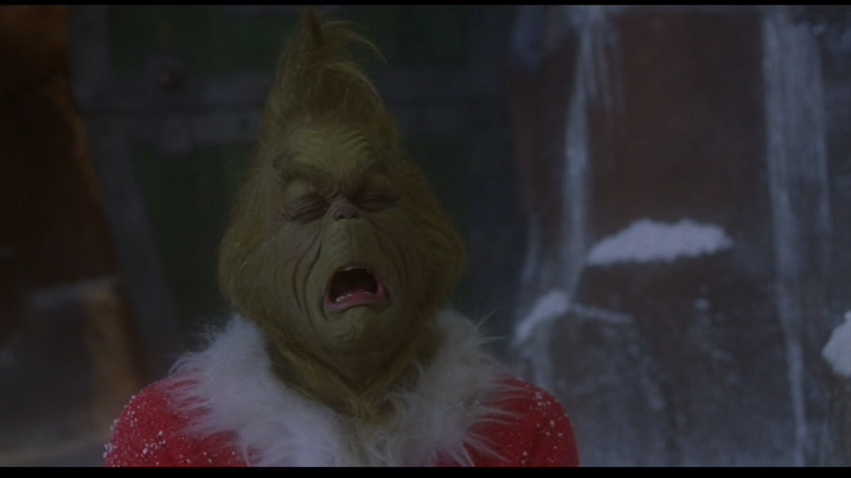

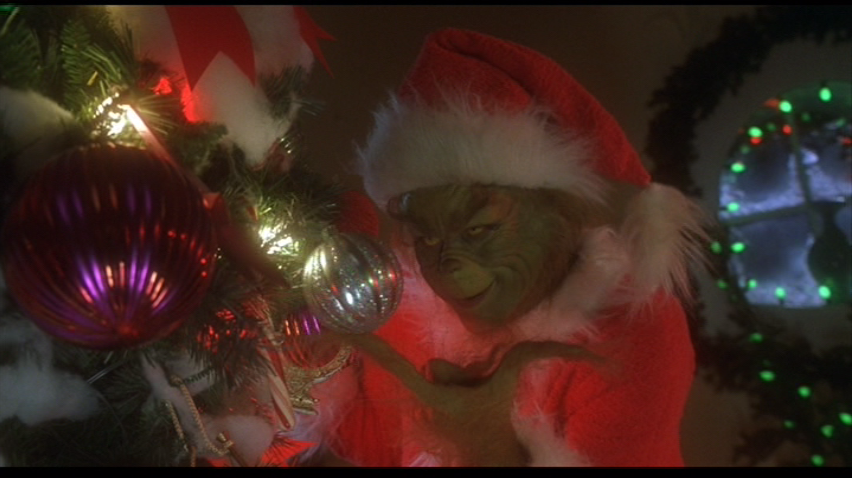
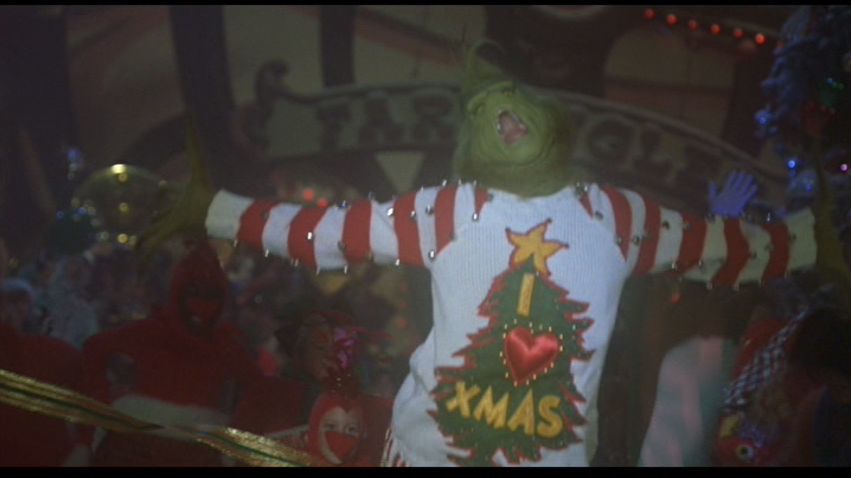
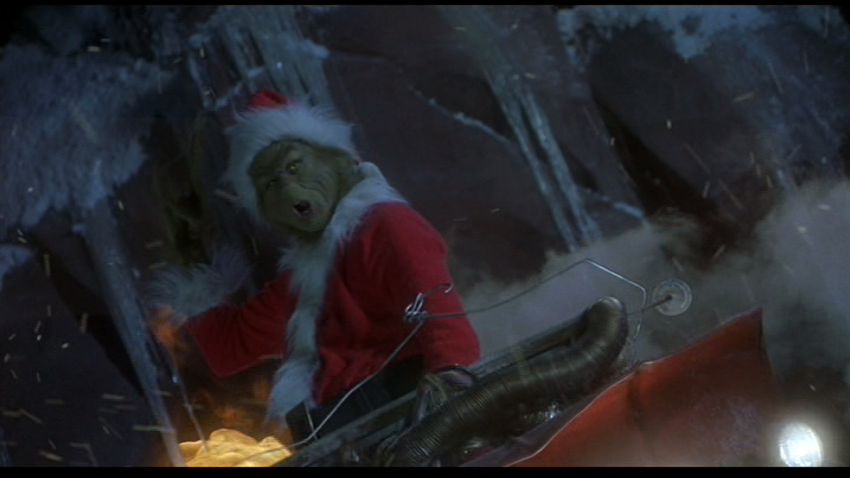
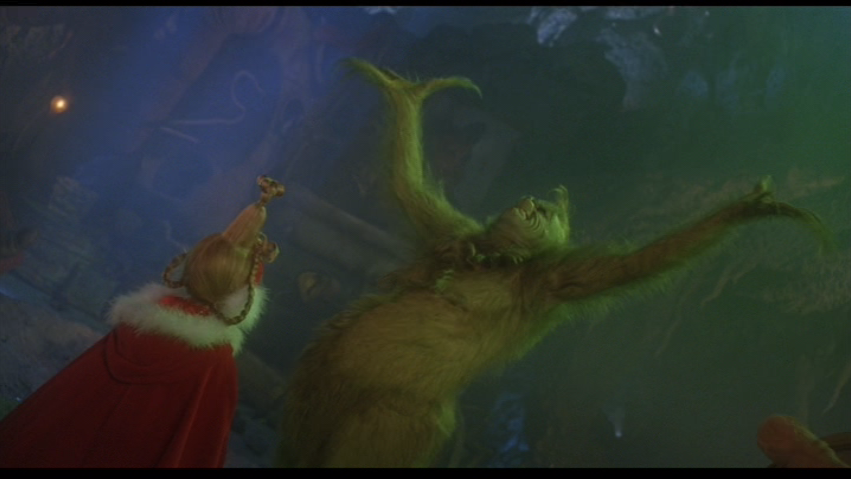
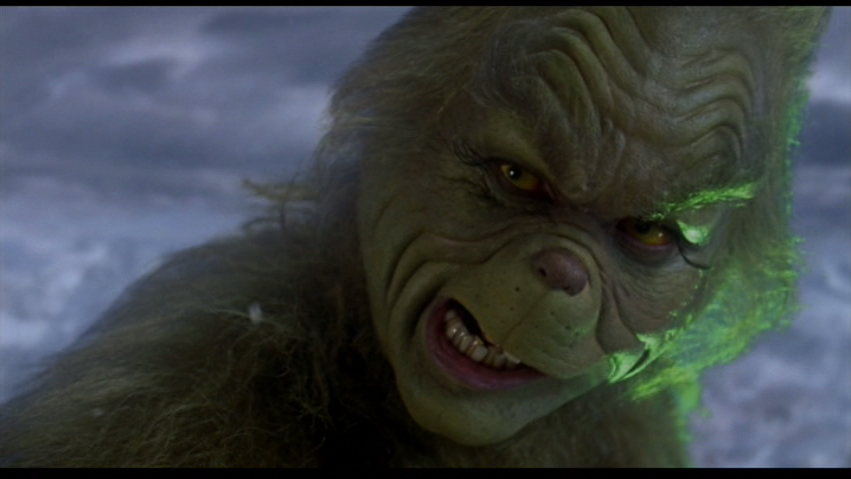
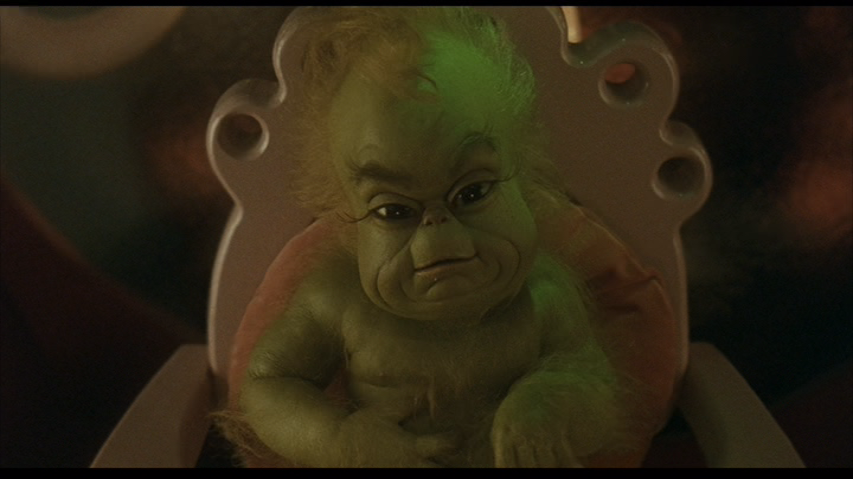
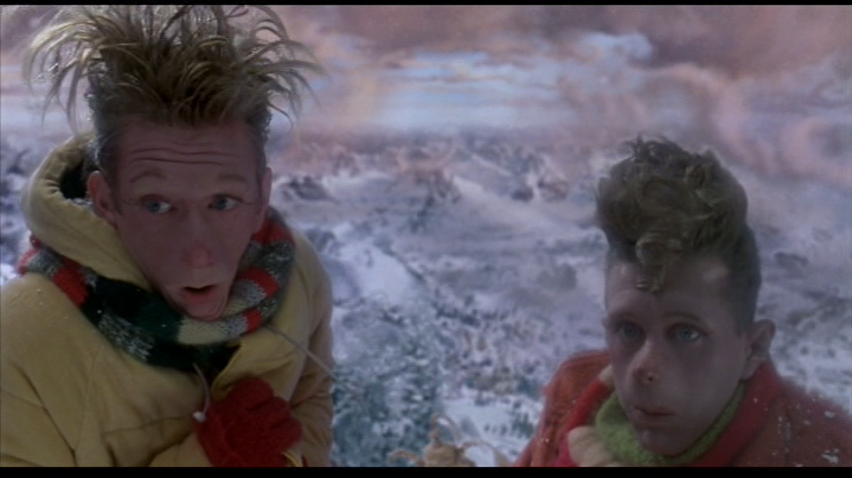
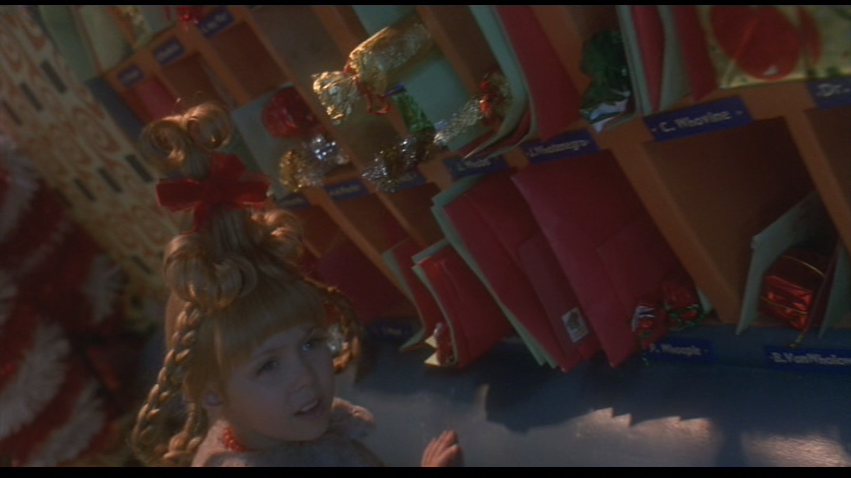

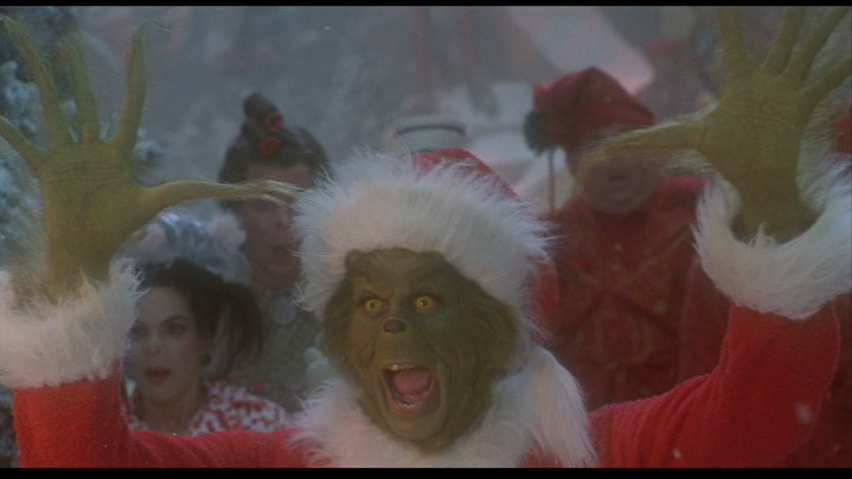

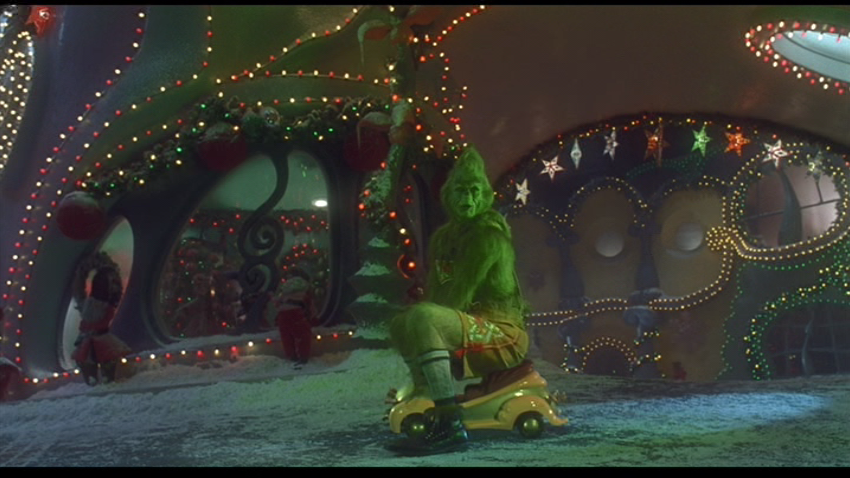
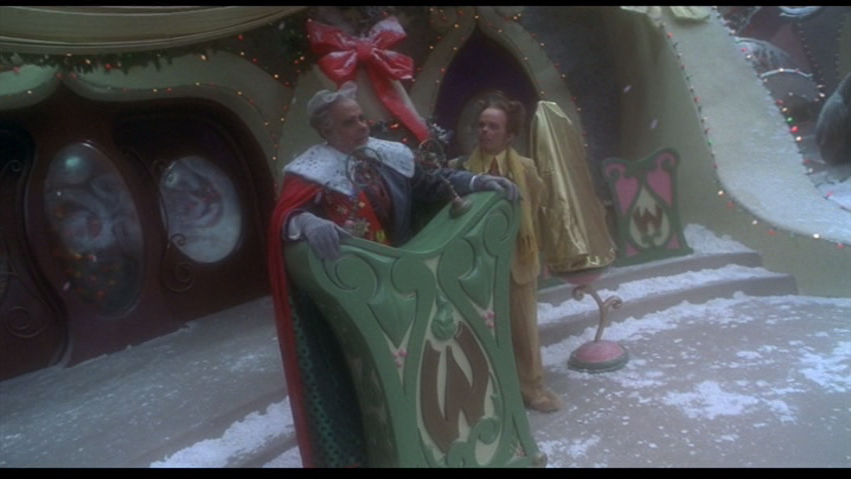
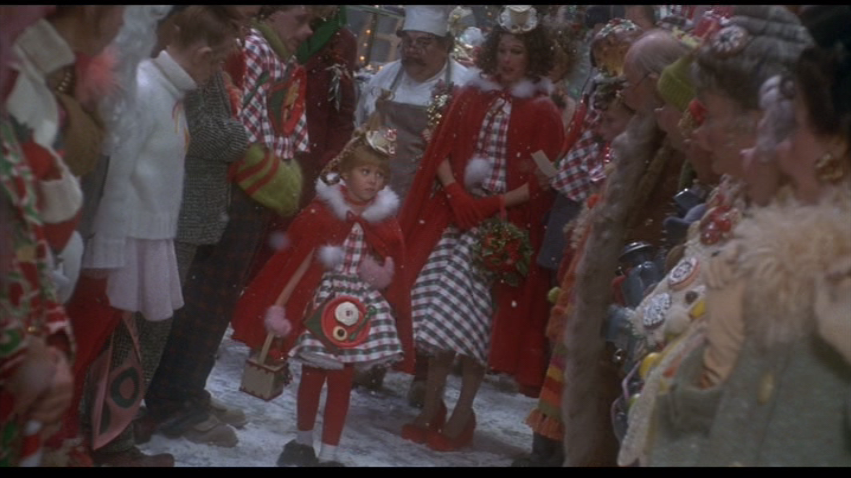
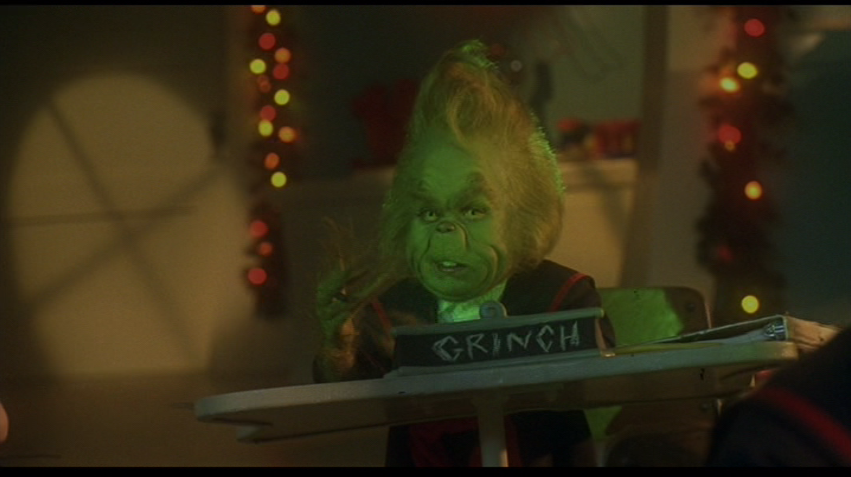
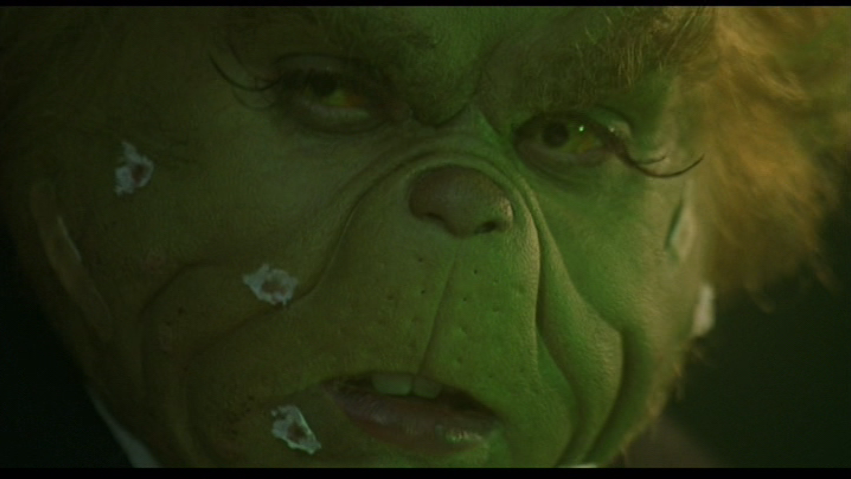
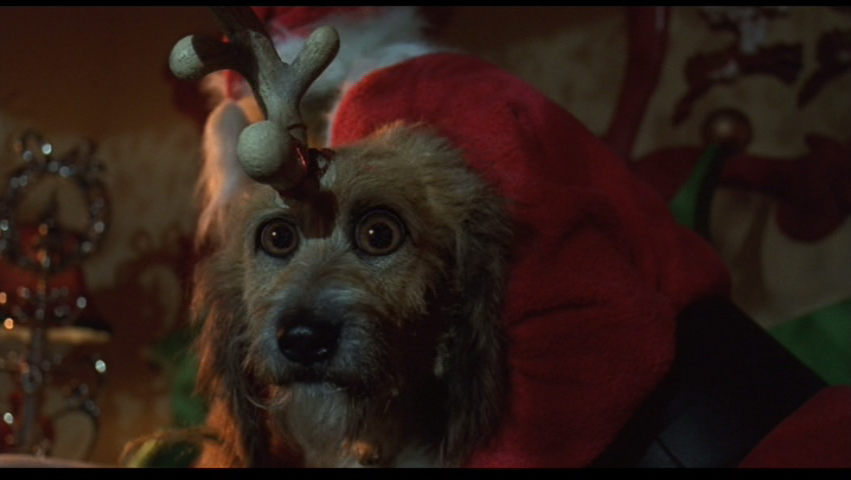
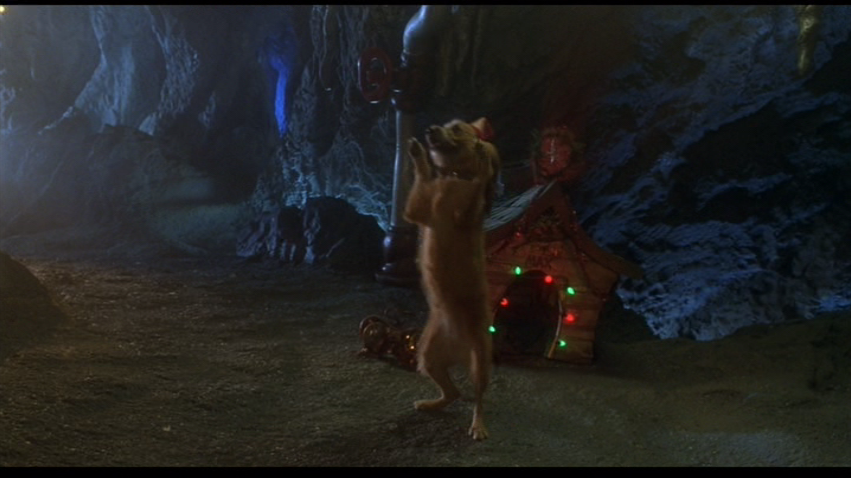
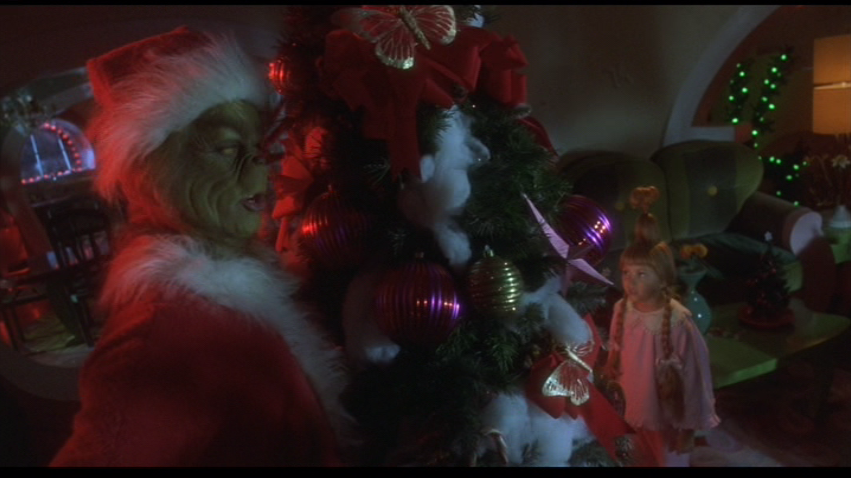

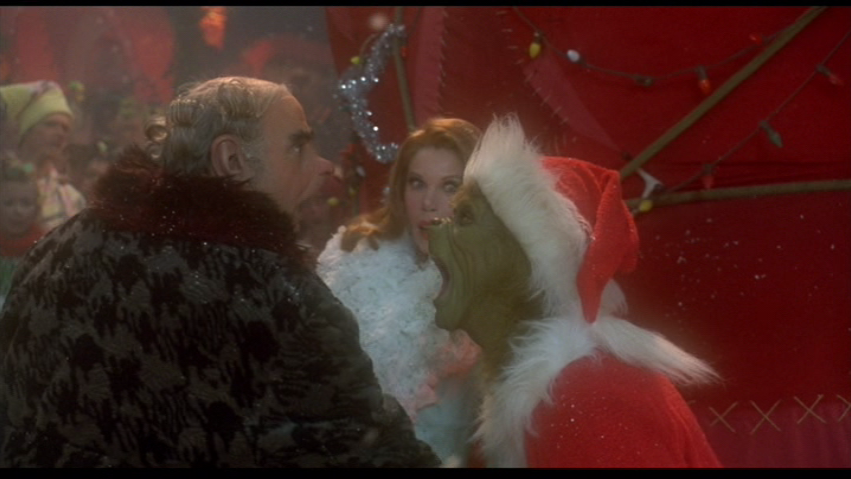
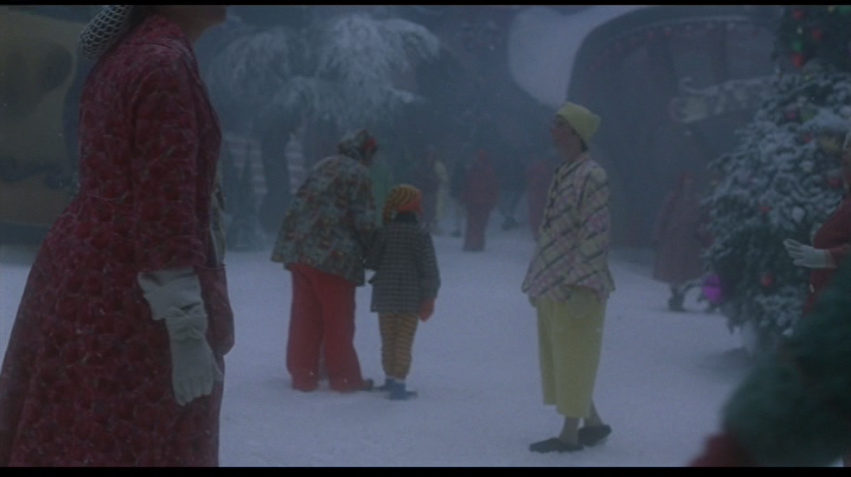

why is alf green this week
To distract you from the fact that he hid all the eggs.
“It’s easy to imagine Ron Howard’s live-action adaptation of A Charlie Brown Christmas in which all of the other kids surround Chuck and chant “Get over yourself,” for two hours before the credits roll.”
So now I’m thinking about how they would do a live-action Charlie Brown film, but attempt to make-over the actors in such a way as to approximate Schultz’s illustrations, a la “The Grinch” and “Cat in the Hat.” It’s nightmare-inducing.
–
The only good thing about this film is the ugly Christmas sweater that Jim Carrey is wearing in that one screencap. I would win so many party prizes in that thing.
http://media1.popsugar-assets.com/files/2015/10/30/625/n/1922398/c20c3ec5_edit_img_cover_file_38929986_1446213295_GettyImages-49CGWYHP.xxxlarge/i/Today-Show-Peanuts-Halloween-Costumes.jpg
Thanks for that. :P
Weird that Clint Howard didn’t get any prosthetics or makeup.